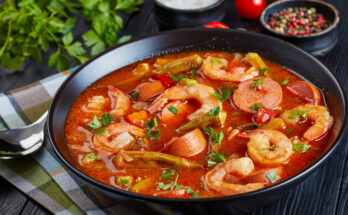Creamed Onions Recipe: Creamed onions are one of those timeless side dishes that bring comfort, warmth, and elegance to the table. Imagine tender pearl onions bathed in a velvety cream sauce—rich, flavorful, and the perfect complement to hearty main dishes. This recipe has been around for generations, often making its way onto holiday tables alongside turkey, roast beef, or ham. It’s a dish that feels both traditional and indulgent, reminding us of family gatherings, festive dinners, and cozy winter evenings.
So why are creamed onions so beloved? The magic lies in the balance between the sweetness of onions and the richness of cream. Onions, when gently simmered, lose their sharpness and develop a natural sweetness that pairs beautifully with a creamy béchamel or cream-based sauce. This creates a silky, luxurious dish that feels like comfort food but also carries a touch of sophistication.
Creamed onions also shine during festive seasons—especially Thanksgiving and Christmas. Many families pass down their version of this recipe, often tweaking the sauce with nutmeg, cheese, or herbs. But beyond holiday meals, this dish can also be enjoyed any time you want to elevate a simple dinner. Imagine serving it with roasted chicken on a chilly evening or even as a side for grilled meats in summer—it never disappoints.
In this guide, we’ll cover everything you need to make the perfect creamed onions at home, from selecting the right ingredients to cooking tips, variations, and serving suggestions. By the end, you’ll have a foolproof recipe that you can proudly serve at any gathering—or enjoy for yourself when you crave a comforting, creamy side dish.
Ingredients You’ll Need
Every great dish begins with the right ingredients, and creamed onions are no different. The beauty of this recipe is that it doesn’t require anything complicated—just simple, wholesome ingredients that come together to create something truly special.
Main Ingredients:
- Pearl onions (about 2 pounds) – The star of the dish. Their small size and naturally sweet flavor make them ideal for creamed onions.
- Butter (4 tablespoons) – Adds richness and forms the base of the sauce.
- All-purpose flour (4 tablespoons) – Used to make a roux, which thickens the cream sauce.
- Whole milk or heavy cream (2 cups) – The key to that velvety smooth sauce. You can mix milk and cream for balance.
- Salt and black pepper (to taste) – Enhances flavor.
- Nutmeg (a pinch, optional) – Adds warmth and depth.
Optional Add-ins for Extra Flavor:
- Grated Parmesan cheese or Gruyère for a cheesy twist.
- Fresh parsley or thyme for herbal notes.
- A splash of white wine for subtle acidity.
Substitutions for Dietary Preferences:
- For a lighter version, substitute half-and-half or even evaporated milk instead of heavy cream.
- For a gluten-free version, use cornstarch or gluten-free flour instead of all-purpose flour.
- For a vegan alternative, replace butter with olive oil or vegan butter, and use plant-based cream (such as cashew cream or oat cream).
By preparing these ingredients ahead of time, you’ll make the cooking process smooth and stress-free. It also allows you to customize the recipe to suit your taste or dietary needs.
Essential Kitchen Tools
Before diving into the cooking process, it helps to have the right tools on hand. While this recipe is straightforward, the right equipment will make everything easier and more efficient.
Key Tools:
- Large saucepan or Dutch oven – Perfect for boiling onions and later combining them with the sauce.
- Medium saucepan – For preparing the cream sauce separately.
- Sharp knife and cutting board – For trimming onions if needed.
- Slotted spoon – Useful for lifting onions out of boiling water.
- Whisk – Essential for making a smooth, lump-free cream sauce.
- Mixing bowls – Handy for holding onions before they’re added to the sauce.
Helpful Tips:
- To peel pearl onions easily, blanch them in boiling water for a couple of minutes, then transfer them to an ice bath. The skins will slip right off.
- Use a whisk instead of a spoon when making the roux—this prevents clumps and gives a silky sauce.
- A heavy-bottomed saucepan works best for the cream sauce, as it prevents scorching and allows even heating.
Having everything ready before you begin will make the cooking process much smoother, especially if you’re preparing this dish alongside other holiday recipes.
Step-by-Step Guide to Making Creamed Onions
This recipe may sound fancy, but the truth is, it’s incredibly simple once broken down into steps. Follow this guide, and you’ll end up with the creamiest, most flavorful onions every single time.
Step 1: Choosing the Right Onions
Pearl onions are the go-to choice because of their size and sweetness. Look for onions that are firm, smooth, and about the size of a marble. White pearl onions are most traditional, but red or yellow pearl onions can add a unique twist.
Step 2: Preparing and Peeling Onions
This step can feel tedious, but blanching makes it easy. Place the onions in boiling water for 2 minutes, then plunge them into an ice bath. Cut off the root end, and the skin will pop right off when you squeeze gently.
Step 3: Cooking the Onions to Tender Perfection
Once peeled, simmer the onions in salted water until just tender—about 10 minutes. You don’t want them mushy, just soft enough to melt in your mouth. Drain and set aside.
Step 4: Making the Creamy Sauce
In a medium saucepan, melt butter over medium heat. Whisk in the flour to form a roux, cooking for about 2 minutes. Gradually whisk in milk or cream until smooth. Continue cooking until thickened, then season with salt, pepper, and nutmeg.
Step 5: Combining Onions with Cream Sauce
Add the cooked onions to the cream sauce, gently folding them in so they’re fully coated. Let them simmer together for a few minutes to allow the flavors to meld.
Step 6: Adjusting Seasonings and Consistency
Taste and adjust as needed. If the sauce is too thick, add a splash of milk. If you prefer a bolder flavor, stir in some grated cheese or fresh herbs.
At this point, your creamed onions are ready to serve—but if you’d like, you can transfer them to a baking dish, sprinkle with breadcrumbs and cheese, and broil until golden for an extra-special finish.
Variations of Creamed Onions
While the classic version is always a winner, sometimes it’s fun to experiment and give the dish your own personal twist. Creamed onions are incredibly versatile, so a few tweaks can take them in a whole new direction without losing that comforting essence.
Cheesy Creamed Onions
If you’re a cheese lover, this variation will hit the spot. After preparing the cream sauce, stir in about 1 cup of grated Parmesan, Gruyère, or cheddar cheese before adding the onions. The result is a richer, more indulgent side dish with a hint of sharpness from the cheese. For an extra treat, sprinkle breadcrumbs and additional cheese on top, then bake until bubbly and golden brown. This makes the dish heartier and perfect for pairing with roasts.
Vegan and Dairy-Free Options
Want to make creamed onions without dairy? No problem! Replace butter with vegan margarine or olive oil, and use plant-based cream like cashew cream, almond cream, or even oat cream. For thickening, use cornstarch instead of flour. The result is still luxuriously creamy but completely dairy-free. If you want a cheesy flavor without cheese, add a spoonful of nutritional yeast—it gives that umami kick while keeping things vegan.
Adding Herbs and Spices
Herbs can completely transform this dish. Fresh thyme or rosemary adds an earthy aroma, while parsley brightens things up. For a touch of warmth, try a sprinkle of paprika or cayenne pepper. Some cooks even add a dash of curry powder for a subtle, exotic twist. Spices not only deepen the flavor but also make your version of creamed onions unique.
Serving Suggestions
Now that your creamy masterpiece is ready, let’s talk about how to serve it. Creamed onions are delicious enough to stand on their own, but they truly shine when paired with the right dishes.
Pairing with Holiday Meals
This dish is a holiday classic for a reason. Imagine a Thanksgiving spread: roast turkey, stuffing, cranberry sauce, mashed potatoes—and right there in the middle, a bowl of creamed onions bringing richness and sweetness to balance the meal. They also complement roast beef, glazed ham, or lamb beautifully. On Christmas tables, they often become a tradition alongside other festive favorites.
Everyday Dishes That Work Well
Don’t save creamed onions only for holidays. They can make a simple weeknight dinner feel special. Pair them with:
- Grilled chicken or steak for a restaurant-quality meal at home.
- Roasted salmon or cod for a comforting seafood option.
- Vegetarian mains like stuffed squash, mushroom risotto, or baked lentil loaf.
If you’re looking for a way to dress up a basic dinner, a bowl of creamed onions instantly adds elegance.
Storage and Reheating Tips
Like many creamy dishes, creamed onions taste even better the next day, once the flavors have had time to meld. The key is storing and reheating them properly so they don’t lose their luscious texture.
Refrigeration and Freezing Guidelines
- Refrigeration: Store leftovers in an airtight container in the fridge for up to 3–4 days.
- Freezing: Cream-based sauces don’t always freeze perfectly, but if you must, freeze in a tightly sealed container for up to 2 months. Keep in mind the texture may change slightly when thawed.
Best Way to Reheat Without Losing Creaminess
- Reheat on the stovetop over low heat, adding a splash of milk or cream to loosen the sauce if it thickens too much.
- Alternatively, warm in the microwave in short intervals, stirring in between to keep the sauce smooth.
- If baking, cover with foil to prevent drying out, and bake at 325°F until heated through.
Handled properly, creamed onions can be just as delicious when reheated as when freshly made.
Nutritional Value of Creamed Onions
You might be surprised to learn that while creamed onions are indulgent, they still come with some nutritional perks. Onions themselves are packed with health benefits, and even when coated in cream, they’re not all bad news.
Calories and Macronutrients
On average, one serving of creamed onions (about ½ cup) contains around:
- Calories: 150–200 (depending on cream or milk used)
- Fat: 10–14g
- Carbohydrates: 12–15g
- Protein: 2–4g
This makes it a rich but manageable side dish, especially when balanced with lighter items on the plate.
Health Benefits of Onions
- Rich in antioxidants: Onions are a great source of quercetin, which helps fight inflammation.
- Heart health: They may help lower cholesterol and blood pressure.
- Immune boost: Onions have antibacterial and antiviral properties.
- Digestive support: High in fiber, they promote gut health.
So yes, creamed onions are creamy and comforting, but they also sneak in some real nutritional goodness.
Pro Tips for the Perfect Creamed Onions
Even though creamed onions are simple to prepare, a few tricks can make them absolutely flawless. With the right techniques, you can avoid common mistakes and elevate the flavor to restaurant-quality.
Avoiding Common Mistakes
- Overcooking the onions – Pearl onions should be tender but not mushy. Boiling them too long will make them fall apart in the sauce. Test by piercing with a fork; they should be soft yet hold their shape.
- Lumpy sauce – This usually happens if you add milk too quickly to the roux. Always whisk gradually and keep stirring to get a silky smooth texture.
- Bland flavor – Cream alone can sometimes feel flat. Don’t forget to season well with salt, pepper, and optional nutmeg to bring out the sweetness of the onions.
- Sauce too thick or thin – If too thick, loosen with a splash of milk. If too thin, cook a bit longer to reduce or whisk in a tiny slurry of flour and water.
Expert Flavor Enhancements
- Add a splash of white wine or sherry to the sauce for depth and sophistication.
- Stir in grated cheese like Gruyère or Parmesan for richness.
- Finish with a sprinkle of fresh herbs—parsley for brightness, thyme for earthiness, or chives for a subtle oniony kick.
- For a gourmet touch, top with toasted breadcrumbs before baking. This gives a crunchy contrast to the creamy sauce.
Mastering these little details will ensure your creamed onions are consistently creamy, flavorful, and a star at any dinner table.
FAQs about Creamed Onions Recipe
1. Can I use frozen pearl onions?
Yes! Frozen pearl onions are a great shortcut. Just thaw them before adding to the sauce. They save peeling time without compromising taste.
2. How can I make creamed onions gluten-free?
Replace the all-purpose flour in the roux with cornstarch or a gluten-free flour blend. The sauce will thicken just as nicely.
3. Can I prepare creamed onions ahead of time?
Absolutely. Make them a day in advance and refrigerate. Reheat gently on the stovetop with a splash of cream to restore smoothness.
4. What’s the best cream substitute for a lighter version?
Half-and-half or evaporated milk works well for a lighter sauce without losing too much richness. You can also use a mix of milk and broth for extra flavor.
5. How long do creamed onions last in the fridge?
Stored in an airtight container, they keep well for 3–4 days. For longer storage, freeze for up to 2 months, though the texture may change slightly.
Conclusion
This recipe is more than just a side dish—it’s a piece of culinary tradition. Whether you’re making them for Thanksgiving, Christmas, or a simple family meal, creamed onions bring warmth, elegance, and flavor that guests will remember. Plus, with easy storage and reheating, you can enjoy them beyond the first serving.
So next time you want to impress your family or guests with something special, skip the store-bought sides and whip up a bowl of homemade creamed onions. Simple ingredients, a few steps, and a whole lot of flavor—it’s the kind of recipe that turns any meal into a memorable occasion.



